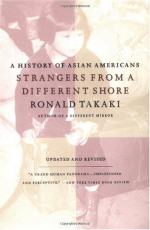
|
| Name: _________________________ | Period: ___________________ |
This test consists of 15 multiple choice questions and 5 short answer questions.
Multiple Choice Questions
1. Where did Asian-Indian workers work in Washington?
(a) Libraries.
(b) Lumber yards.
(c) Steel mills.
(d) Fish markets.
2. In what year did Hawaiians recruit Asian-Indian workers?
(a) 1865.
(b) 1943.
(c) 1825.
(d) 1902.
3. Where did Kuomintang of Chiang Kai-shek flee to?
(a) Thailand.
(b) Paris.
(c) Tawaiin.
(d) Hawaii.
4. Which group is the largest of Asian immigrants?
(a) Korean.
(b) Filipino.
(c) Chinese.
(d) Japanese.
5. Why did many Filipinos come to America?
(a) The higher wages.
(b) The freedom of religion.
(c) The Macros regime.
(d) The Mauns regime.
6. Who did The Chinese Six Companies support when China was taken over by communists?
(a) America.
(b) Kuomintang of Chiang Kai-shek.
(c) Communist China.
(d) No one.
7. What did Chinese soldiers bring to the United States between 1948 and 1953?
(a) Chinese brides.
(b) Children.
(c) Drugs.
(d) Spy documents.
8. What Chinese immigrants were allowed to bring their wives?
(a) Lawyers.
(b) Merchants.
(c) Farmers.
(d) Doctors.
9. Why did people immigrate from Laos?
(a) Civil strife.
(b) Dreams of a better education system.
(c) Poverty.
(d) America invited them.
10. When did the Filipinos begin to migrate?
(a) 1905.
(b) 1837.
(c) 1945.
(d) 1910.
11. Why did most Asian immigrants want to move to America?
(a) For a better life.
(b) To escape criminal charges.
(c) Political exile.
(d) Better farming.
12. What illegal papers caused someone to be called a "paper son."
(a) Immunizations.
(b) Citizenship papers.
(c) Death certificate.
(d) Birth certificate.
13. When did a large number of Koreans immigrate to American?
(a) After 1885.
(b) After the earthquake of 1906.
(c) After 1945.
(d) After the tornado of 1922.
14. Why did people move from Korea to the United States?
(a) Better jobs.
(b) Less pollution.
(c) Better government.
(d) Better schools.
15. Where did most Asian immigrants settle?
(a) Hawaii.
(b) Hawaii, Michigan and Chicago.
(c) California, Hawaii and New York.
(d) New York and Michigan.
Short Answer Questions
1. In 1910, who did the United States courts rule were white?
2. Where did Takaki grow up?
3. Where did the majority of Korean immigrants settle?
4. What did the Alien Land Law prevent?
5. Who had conflicts with the Asian-Indian workers?
|
This section contains 316 words (approx. 2 pages at 300 words per page) |

|




